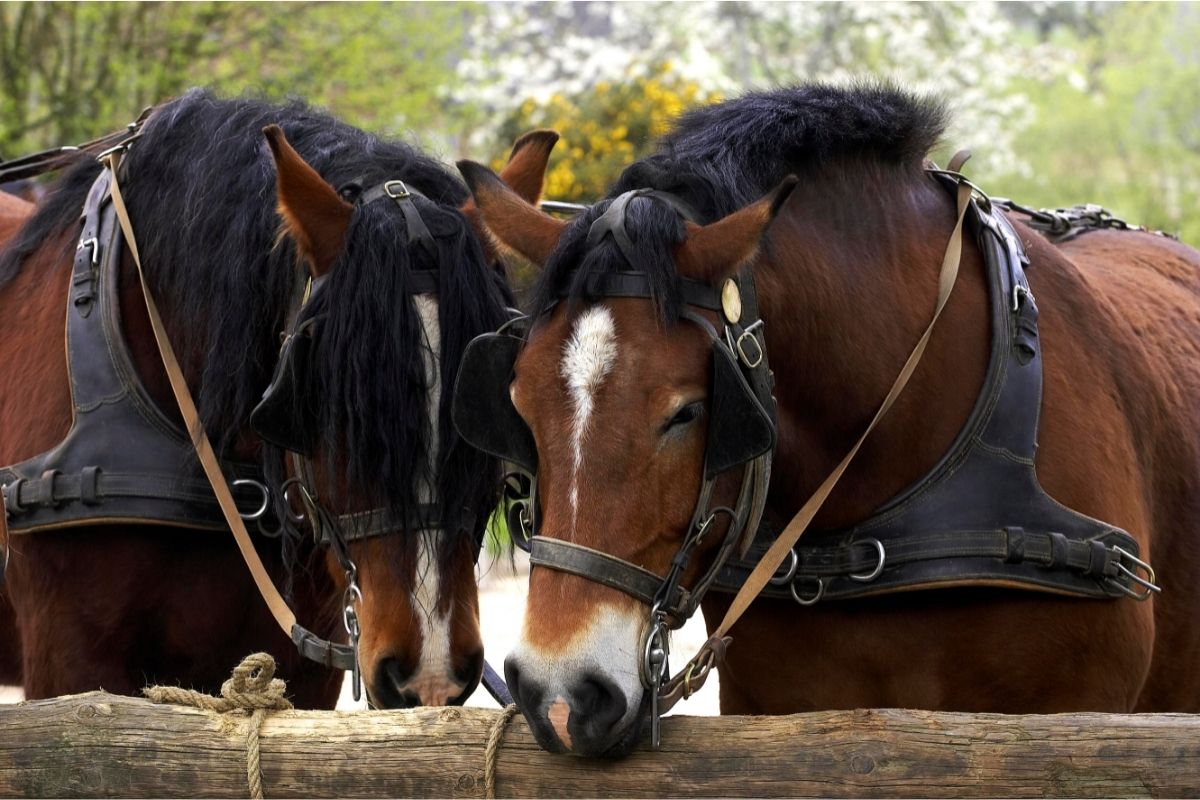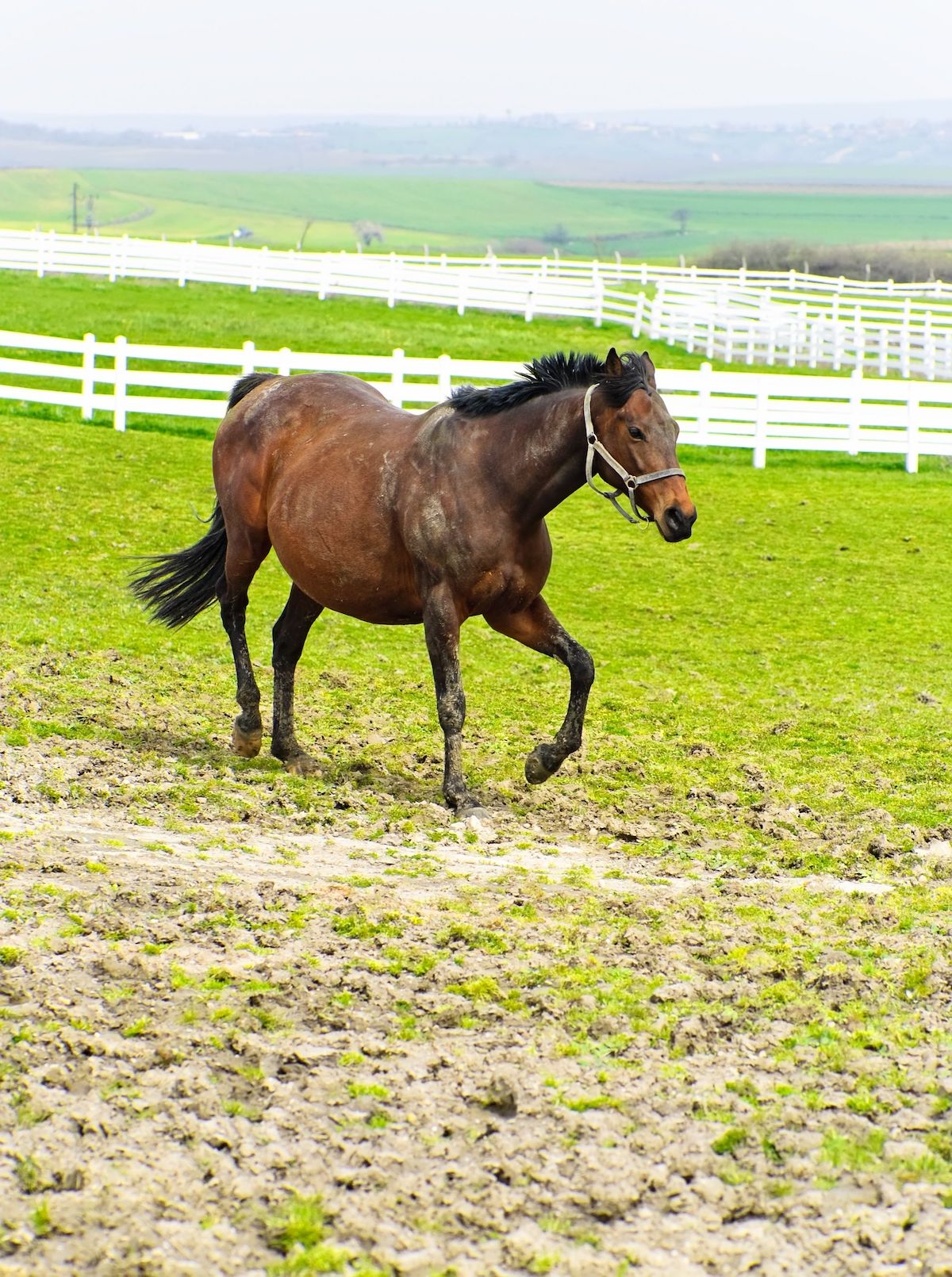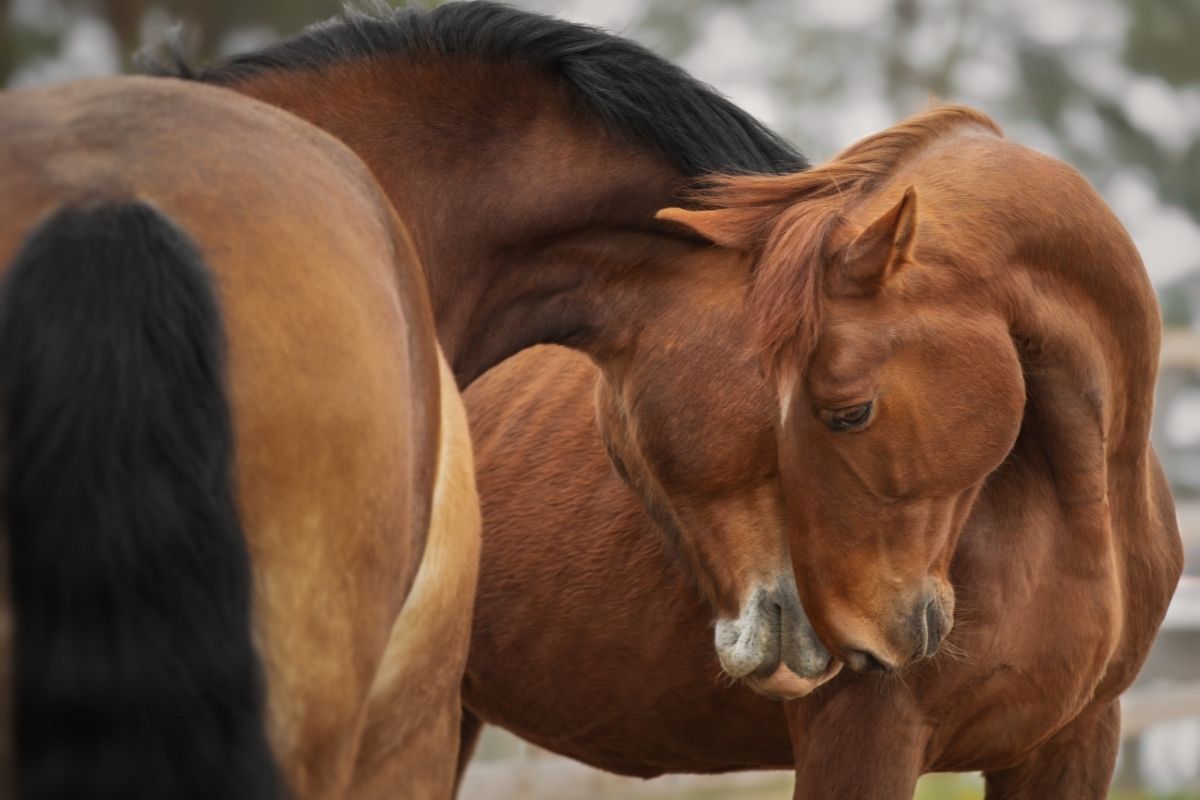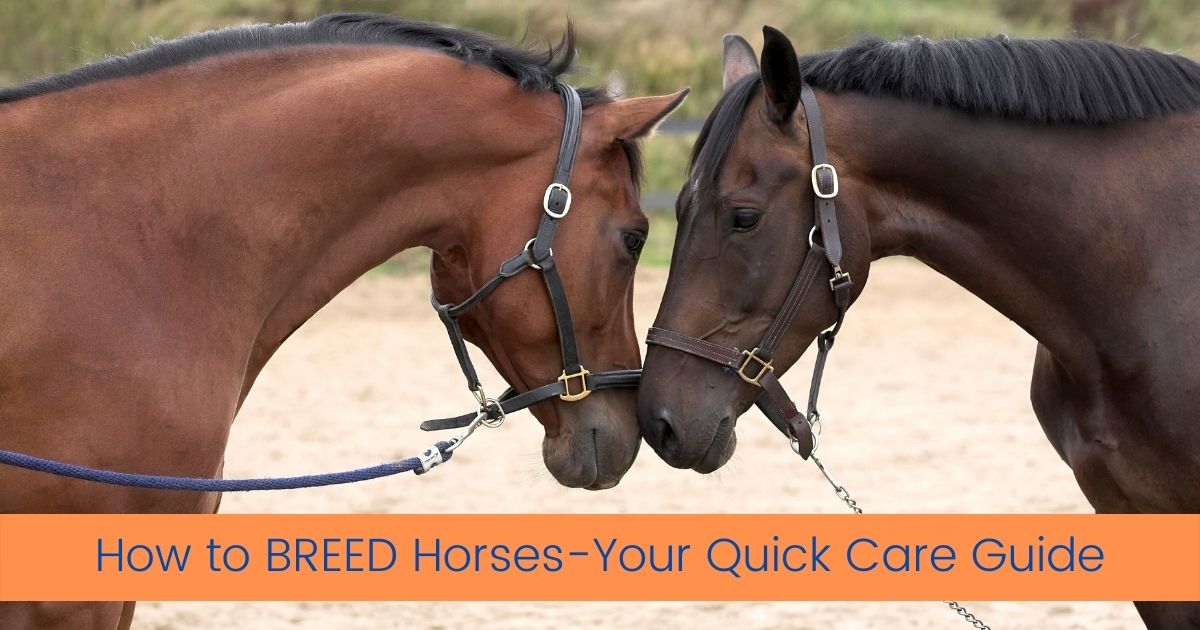The Basics of Horse Breeding
If you want to learn how to breed horses, you should learn that horse breeding is both a science and a business. You cannot successfully initiate how to breed horses in real life without incurring huge expenses. So, it is best to get very familiar with the horse breeding process before you pay for anything.
The reason that the process can cost a lot is that you will be paying the veterinarian for their time, effort, experience, and skills in how to breed horses. You will also have to compensate those assisting the vet during the initial mating attempts. Then there are the other necessary expenses that go into the process to consider, such as wages of farmhands.
The good news is that with the correct procedures in place, your veterinarian will be able to help your mare produce healthy foals. That way, your investment will be worth the time and effort to shell out.

The Role of the Stallion in Equine Reproduction
Before you start the horse breeding process, the very first thing you should consider is choosing a stallion and a mare to mate together. When it comes to mating two horses, you should have the vet examine both stallion and mare to see if they’re healthy enough to mate.
The stallion horse, in particular, is a very important factor to consider because there is a time limit for any stallion to produce sufficient healthy sperm. Once the stallion is 20 years old, it usually cannot be relied upon for horse breeding anymore. Some male horses can also taper off, producing sufficient viable sperm before they reach 20 years of age.
The stallion owner would have to find healthy mares for their male horse to breed with as soon as the stallion reaches two years of age. This would help the stallion owner maximize the profitability of horse breeding within the remaining 18 years of the stallion’s sperm viability.
It should be stressed though, that a stallion that does breed foals isn’t automatically a keeper if the foals are not strong or healthy. The clients who would buy the foals would need proof that their money will not be wasted. That is why stallions that do produce strong foals are highly prized.
The Breeding Rates of Healthy Stallions
As you can imagine, a healthy stallion will be highly prized if successive mating produces strong and healthy foals. One stallion horse with a good breeding rate can be worth much since many generations of foals could be born and raised. So, if you are looking to mate your mare, always consider the breeding rate of the stallion first.
If a stallion has a low breeding rate, the vet may think it is necessary to administer semen tests. This would take into account the following:
Testicular Parameters
- Shape
- Size
- Total scrotal width
- Volume
- Ultrasonographic appearance
Semen evaluation is another factor that can affect the breeding rate. To conduct semen evaluation, you should look for:
- Color
- Turbidity
- pH
- Presence of somatic cells or germ cells
These would be part of the examination of seminal fluid features and sperm morphologic and movement patterns.
Some stallions may be infertile even after all these characteristics are uncovered during a semen test. That is also why a reputable veterinarian with much experience in horse fertility is in demand among horse breeding circles. First, a vet needs to check if the stallion has the following to be considered a contender for mating:
- Absence of genetic or physical defects that a foal could inherit.
- Lack of transmittable diseases (such as venereal disease).
- Absence of behavioral disorders.
- Lack of physical abnormalities that will obstruct the mating process.
- Possess sufficient output of normal sperm.
Based on these factors, the vet will classify a stallion horse as:
- Unsatisfactory
- Questionable
- Satisfactory, with regards to its breeding prospects.
This classification will determine if the stallion can be “booked” for breeding with eligible mares.
A stallion with a prolific breeding rate of over 135 to 150 days (the normal breeding cycle) can mate with 40 to 45 mares through natural service. However, if artificial breeding is done in that same cycle, the stallion horse may mate with 120 to 140 mares.
Of course, the mares must be in good health and ready for mating when a stallion attempts to breed with them. So, it’s a 50/50 situation since both stallion and mare have to be reasonably healthy to produce strong and healthy foals.
Feeding and Management of Breeding Mares
As previously mentioned, it is the veterinarian’s responsibility to determine if a mare is healthy enough to be subject to mating with a stallion horse. Once mating is consummated, the broodmare owner will wait to see if a pregnancy follows.
It is equally important to learn how to breed horses as it is to be concerned about the welfare of breeding mares since the foal will be carried in the mare’s womb if mating is successful. Therefore, to produce a healthy mare, you need to carefully consider its feeding and management before mating, after mating, and during pregnancy.
The vet may rely on the Body Condition Score (BCS) system to determine the state of health of a mare. This BCS starts with BCS 1, describing a very emaciated, skeletal horse, and progresses up to BCS 9, where the mare is obese. Naturally, the vet will then devise a feeding program regarding the mare’s feeding and management, so it will be ready to carry a pregnancy to term.
The vet should prescribe a diet rich in calories and nutrients if the mare is too thin. Suitable components of such a diet could be corn and oats. Forage such as hay or grazing pasture will also be satisfactory for some mares. The key is to increase the volume of feed and forage in increments so that the mare’s body will adjust slowly too.
If the mare is already pregnant, the vet may prescribe a commercially-available diet known as a concentrate for the broodmare. This will help the mare feed the foal in its uterus during the entire term of its pregnancy. The vet may recommend either pellets or sweet feed as the commercial feed. Sweet feed concentrate is also called “open mix” or “textured feed.”
The vet should also consider the season when the pregnancy is being observed. The mare should have a “safe” amount of body fat to insulate itself and the unborn foal from extreme cold conditions during winter. The vet may opt to increase the concentrate to increase body fat if needed. During winter, the mare should have a BCS of around 5 or 6.
To calculate the correct calorie intake of the mare, the vet should take into account the following:
- The body weight and size of the mare.
- The BCS of the mare at the start of the feeding program.
- The target BCS at the end of the feeding program.
The vet should also factor in the condition of the foal in the womb when computing for the nutrient requirement of the broodmare. The vet will consider the development of the unborn foal so that the concentration level will be more than sufficient for both mare and foal. Otherwise, the mare’s own body will “donate” nutrients to the foal, jeopardizing the mare’s health.
Ideally, the mare should have a minimum BCS of 5 during the pregnancy to be considered healthy. Naturally, as the pregnancy reaches full term, the mare will probably eat less since the foal occupies more space in her belly. In this case, it is best if the vet staggers the feeding schedule yet increases the concentrated amount.

Methods of Mating in Horses
You may be wondering how to make horses breed. This is very important for anyone who wants to care for horses because sometimes the mating conditions are not ideal and will require human intervention.
The techniques for horse breeding can be different from learning how to breed horses and donkeys. In horse breeding, you would be breeding a stallion horse with a male or female horse to produce a foal. When breeding horses and donkeys, the male donkey would be paired with a female horse or mare to produce a mule.
There are three different mating method categories that you can implement for your mare or stallion.
The first is the “live cover,” which means the stallion will mount the mare naturally. The second is called “artificial insemination,” which means a technician will collect the sperm of the stallion horse and the mare’s egg for combination under artificial conditions. The third is through other reproductive technologies.
Let’s examine these in greater detail.
With live cover, the owner of a stallion horse would agree to mate it with the mare owned by someone else. The stallion’s owner can also opt to mate one of their mares with that horse. Though this relies on the natural urges of the stallion and mare to mate, it can be done with human intervention to minimize any potential injuries to either horse.
It is still necessary to secure semen from the stallion in artificial insemination. This semen is then supplied in fresh, chilled, or frozen forms to be inserted within the mare’s uterus by human technicians.
This should ideally be done within 24 hours from extraction from the stallion to optimize conception. However, it is still possible to use the semen even beyond 24 hours, though the conception rates will be lower by then. Even frozen sperm can be used if necessary.
The advantages of artificial insemination are many, such as:
- It safeguards the mare and the stallion from any untoward incidents during mating.
- The mare will not have to undergo stressful travel conditions just to mate with a stallion.
- A stallion can be mated with many more mares, while live cover requires just one mare at a time.
- The mare won’t pass on sexually-transmitted diseases to the stallion and vice versa.
- A stallion can mate with mares who are overseas or very far from the location of the stallion if the semen is frozen.
- The owner of the mare can select the identity of the stallion because of its past positive breeding history from a roster of several stallions.
- The mare and the stallion can still mate, even if each has a particular physical ailment that would leave live cover an unviable option.
- The semen of a stallion can still be used in the event of the death of the male horse.
Artificial insemination can be advantageous from a business perspective because horse owners can control the many factors that might go wrong during mating. As a result, the horse owner will be able to maximize their investment while the chances of giving birth to a healthy foal go up as well.
There are four other reproductive technologies that a horse owner may opt for if the life cover and artificial insemination are impossible to do or if the costs are prohibitive. These four are:
- Cloning
- Embryo transfer
- Gamete Intra Fallopian Tube transfer
Cloning is one of the more advanced reproductive technologies. The first successful cloning of a horse occurred in 2003 under the aegis of Italian scientists.
There have been more successful horse cloning projects done after that. This technology is advantageous since the entire animal is cloned, so there are fewer risks of defects.
Embryo transfer is somewhat complicated because it involves two mares and one stallion. This means insemination is done first between one mare and one stallion. Then the fertilized egg is removed from that mare and transferred to a surrogate mare for implantation. The surrogate mare will then carry the foal to term until it’s time to give birth to it.
Although embryo transfer may seem straightforward, it does carry some risks, such as when the surrogate mare isn’t temperamentally suited to pregnancy. In addition, some surrogate mares might also be physically incapable of sustaining the pregnancy up to term.
On the other hand, if successful, embryo transfer may help increase the number of foals produced compared to using one mare only.
One difficulty involved in embryo transfer is that the bloodline of the stallion and the mare could be questioned. So, before the horse owner opts for embryo transfer, they should inquire with the blood registry if the bloodline of the foal will be recognized as valid first. The other difficulty is that the embryo transfer itself is pretty complicated and requires much skill to implement.
Gamete Intra Fallopian Tube transfer will also require a surrogate mare but under slightly different conditions. The original donor mare will supply one egg, while the stallion will supply sperm. But the egg and the sperm will be placed within the oviduct of the surrogate mare only. They will not be combined but allowed to “meet up” within the oviduct itself.
This means that the surrogate mare will only serve as a “hospitable breeding ground” for the egg and the sperm. Once the egg is successfully fertilized, the surrogate mare will carry the fertilized egg to term. The surrogate mare is also expected to suckle the foal until weaning.
As can be seen, these techniques will help reduce the factors that can go wrong while increasing the odds that pregnancy will continue until the birth of the foal. A successful pregnancy would mean that the foal will develop normally so that its owner can sell it when it is time.
The Eight Steps to Successful Mare Breeding
As previously discussed, a mare can get pregnant and carry a foal to term, despite any reproduction problems that may crop up. This means the horse owner and the veterinary team need to follow these eight steps that can lead to successful mare breeding. Here are the eight steps required:
- Let the veterinarian examine the mare to determine its overall health before mating. There is no “one size fits all” veterinary treatment at this stage. Instead, the vet should look for any potential issues that may derail a successful pregnancy.
- The veterinarian should examine the mare if previous breeding attempts have failed. Sometimes, existing issues could have been overlooked in previous checkups. This may mean a less competent veterinarian did the previous breeding examination. A more skilled and experienced veterinarian should be called in to do a more comprehensive evaluation if such was the case.
- Ask the veterinarian about the cycling program for breeding for that particular mare. Generally, a mare will be available for breeding in spring and summer, when the days tend to be longer. But some mares can breed even during fall and winter too. If this seems to be the situation with your mare, it is up to the veterinarian to schedule the time for breeding activities.
- Observe the estrus cycle of the mare. She will be most receptive to breeding activities during the initial seven days of this 21-day cycle. If you are the mare’s owner, it is up to you to do the observation and report to the veterinarian what you observed. This will help you determine when she will most likely be ovulating.
- Fix a schedule solely for breeding the mare. This schedule will include finalizing when the mare will ovulate and when the semen will arrive. As previously mentioned, a lot depends on whether you will rely on live cover breeding or fresh, chilled, or frozen semen from a stallion horse. But the veterinarian will determine which is the best method for insemination. This will depend on the physical examination of the mare to reveal any perceived hindrance to insemination as well.
- The veterinarian may recommend a particular veterinary technology to estimate the time for ovulation. This will help the mare conceive successfully by determining when she would be in heat.
- The veterinarian will promote uterine clearance so that the mare can “clean out” dead sperm and other impurities within the reproductive system. This promotes the health of the uterus. However, if one is used, the surrogate mare might not initiate uterine clearance because the egg was artificially implanted in her oviduct or uterus.
- The mare will get pregnant if there are no problems. The vet will have to work with the horse owner to see if the mare is pregnant or if there are issues hindering conception. If necessary, the vet will make plans for the next time the mare is in heat, should the current cycle fail. If the mare seems to have problems conceiving, the vet may recommend other forms of reproductive technologies instead.

The Final Say
Breeding horses is not just a nice hobby to have for some people. It is an investment that will require big money. This is because you will need to hire a veterinarian, veterinary technicians, and veterinary assistants during the process. There may also be some staff you would need to hire for this particular endeavor, such as the farmhands who care for the animals.
There are also a lot of other expenses involved, such as paying for the feeds of the animals, nutritional supplements, veterinary equipment, and lodging of the mare and stallion. You would also have to pay for the reproductive technologies required if necessary. After all, your main goal is to produce a strong and healthy foal, which you can then sell for a profit.
The investment may or may not produce a strong and healthy foal. You will have a choice between increasing the amount to be invested in future breeding attempts or cutting your losses while it’s not that big yet. Fortunately, veterinary research has progressed by quite a lot nowadays, so it’s always possible that you will be able to breed many foals in the future.
